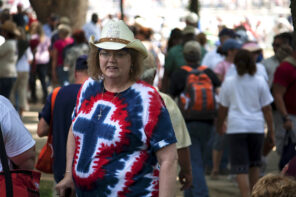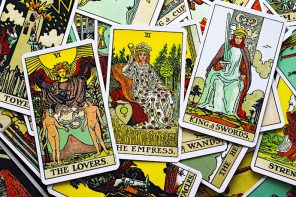“Why do you think girls like Twilight?” I asked my boyfriend’s 11-year-old daughter.
“That’s easy,” she answered. “Boys without shirts.”
When it comes to the casual fan, I gotta say, I think she’s right. The Twilight series is a kind of fashion show in which men model cloaks of masculinity. Their fictional enhancements represent masculine archetypes: Edward the vampire is cold, brooding, and obsessive; Jacob the wolf-man is warm, earthy, and oh yeah, takes his shirt off a lot.
At a time when masculine and feminine ideals are rapidly being redefined, the invitation for girls and women to observe men, admire them, and be choosy among the various types is enough to fill a movie theater—or thousands.
But among the horde of everyday Twilighters like my boyfriend’s daughter are thousands of “Twi-hards,” die-hard fans whose dedication to Twilight verges on the religious. These megafans are the subject of Tanya Erzen’s recently published ethnography, Fanpire.
Erzen describes a world in which “Fanpires” make pilgrimages to the real-life town in which the book is set, write blogs and fan fiction (the most famous of which became Fifty Shades of Grey), and buy buy buy branded Twilight merchandise between the release of the books and movies to keep the magic of the series alive. They “Twi-bond,” supporting one another in times of need (TwilightMoms, an online group of moms who read Twilight, ritually send one another cards and gifts when others in their lives forget to), and they study “Cullenism,” the value system of the Cullens, Edward’s vampire family.
Though the Twi-hard fan movement might not seem worthy of a book-length study, it is part of a widespread American trend away from organized religion and toward the sacralization of pop culture that is worth paying attention to.
As religion-watchers know, the percentage of Americans “unaffiliated” with institutional religion has been rising about one percentage point a year for the past five years. Today, one out of five adults, and more than one in three 18- to 22-year-olds, are religiously unaffiliated.
But “unaffiliated” doesn’t mean unbelieving. Many of these same adults are spiritual. Most believe in God. One-fifth say they pray every day. And a version of religious fervor can be found among both secular and religious fans of just about everything.
Religion scholar David Chidester has famously argued that baseball, Coca-Cola, rock ‘n’ roll, Tupperware—and even the Human Genome Project—serve, for their biggest fans, as “religious fakes,” meaning they play the role of religion, though they aren’t the real thing.
What is interesting about Twilight as a religious fake is that it is distinctly women-centric—a series written by a woman for women. As such, the stories of Fanpires can shed light on what women are lacking in their religious experience—and what leads them to sacralize Twilight, even as many of them remain in traditional religious communities.
Erzen’s 2009 online survey, completed by almost 600 fans, shows that 98 percent of the US Twilight fanbase is made up of women; eighty percent identify as nondenominational Christians or Catholic, while the remainder identify as spiritual. Meanwhile, Erzen one estimate says that over 90 percent of Mormon women have read the series.
So, why Twilight?
Erzen thinks that it has to do with the way Americans are redefining the feminine ideal. Twi-hards express frustration about the contradictory messages they receive from society regarding how a girl or woman is supposed how to look, act and feel: Be good, but not too good; be sexy, but not too sexy.
In Twilight, readers can coolly live a perfect balance of the contradictions, embodying both the sacred and the profane. Bella is a virgin until marriage, but she wants sex and wants it bad; Bella chooses a vampire life with Edward, representing strength and independence, but she didn’t really have to choose because her love for him was so strong that getting married and dedicating herself to him straight out of high school was her only real option; Edward loves Bella, but every day he fights a wild temptation to kill her.
Another reason? There’s a strangely familiar feeling to this seemingly exotic love story.
One of the most potent devotional strains in Christianity is the idea of Jesus as husband: from centuries of Catholic mystical writing to the recent practice, in non-denominational Christianity, of “dating” Jesus.
This history, lodged deeply in Western literary culture, prepares readers for the plot of Twilight: a young woman—clumsy and plain—is deeply and unconditionally loved and protected by an all-powerful, omnipotent being whose love makes her special. For a moment, Twi-hards let themselves believe, however crazy it sounds, that they too could be irresistibly beautiful one day, loved by an ideal God-man who sees them, really sees them.
At the end of the book, Erzen tells us that some of the most active Twi-hards are now moving onto other young adult franchises, like The Hunger Games. That’s the thing about fake religions developed around pop culture fads. They pass with time, and the religious wanderer wanders on, seeking the next transcendent experience.
I went to opening night of the last film in the Twilight franchise, Breaking Dawn: Part 2, for, ahem, “research purposes.” Packed into a sold-out theater in one of New York City’s busiest neighborhoods, I raised my head above the mayhem to get a look at the crowd. Much to my surprise, I didn’t see a single “Bite Me: Vampires Only Please” t-shirt. There were no creepy vampire contacts; no corsets; no capes; even the eyeliner was tastefully applied. I wondered: Where have all the Twi-hards gone?
Suddenly, wolf-man Jacob appeared on screen. The audience clapped wildly. He took his shirt off. Clapping became screaming, and the woman behind me yelled “Oh yeah! Take it off Jacob! That’s my baby daddy up there!”
With the release of its final film, Twilight is already being emptied of its religious significance. But it will always have boys without shirts.




